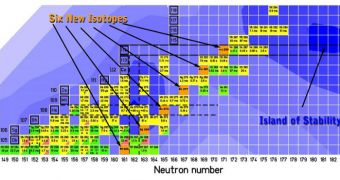Physicists in the US announce the discovery of six new isotopes, which belong to a group of superheavy chemical elements numbered 104 through 114. This achievement will lead to a better understanding of the nuclear shell structure theory, scientists say.
The work was conducted at the US Department of Energy's (DOE) Lawrence Berkeley National Laboratory (Berkeley Lab), in California. Researchers here started by creating a new isotope for the yet-to-be-named element 114.
Progressively, Berkeley physicists obtained new isotopes for copernicium (element 112), darmstadtium (element 110), hassium (element 108), seaborgium (element 106), and rutherfordium (element 104).
The chain of discoveries ended with rutherfordium because the new isotope spontaneously decayed by nuclear fission. But the team is happy with the results it manged nonetheless.
The new isotopes will be included in the theory of nuclear shell structure, a scientific prediction that underlies the concept of an “Island of Stability” for heavy elements, where these structures can endure for extended periods of time.
As elements increase in size, they become less and less stable, until they eventually live for only minute fractions of a second. But the isotopes in the Island of Stability are believed to remain stable for a lot longer, in spite of their high masses.
“We were encouraged to try creating new superheavy isotopes by accelerating calcium 48 projectiles with Berkeley Lab’s 88-Inch Cyclotron and bombarding plutonium 242 targets inside the Berkeley Gas-filled Separator here,” sys Heino Nitsche.
“This was much the same set-up we used a year ago to confirm the existence of element 114,” adds the expert, who holds an appointment as a professor of chemistry at the University of California in Berkeley (UCB).
He is also the head of the Heavy Element Nuclear and Radiochemistry Group at the Berkeley Lab Nuclear Science Division (NSD), and the leader of the new investigation.
Details of the discoveries will be published in print in the October 29 issue of the esteemed scientific journal Physical Review Letters, but they are already available online.
Funds for this investigation came from the DOE Office of Science and the National Nuclear Security Administration (NNSA).
The research team included experts from the Berkeley Lab, UCB, the Lawrence Livermore National Laboratory, the GSI Helmholtz Center for Heavy Ion Research in Germany, the Oregon State University, and the Institute for Energy Technology, in Norway.

 14 DAY TRIAL //
14 DAY TRIAL //